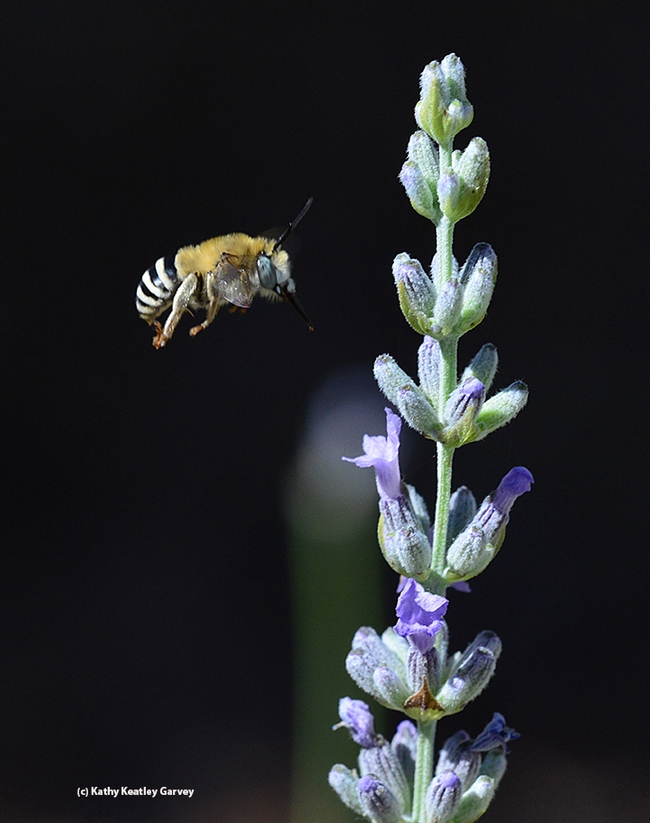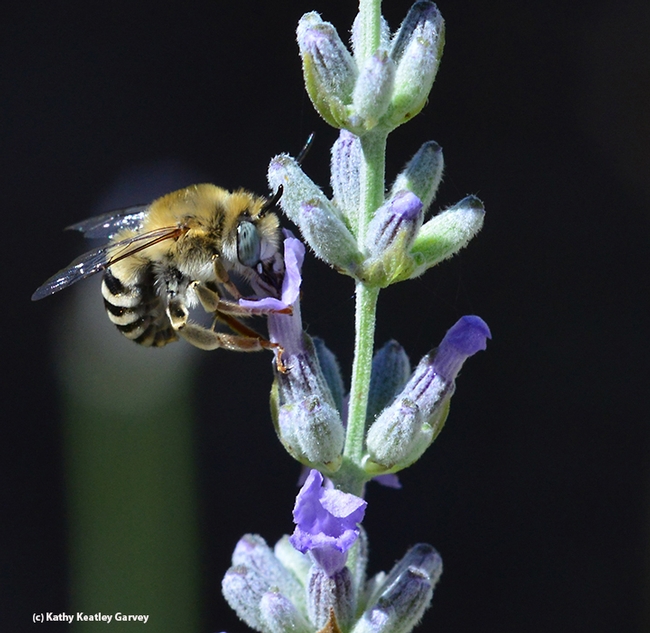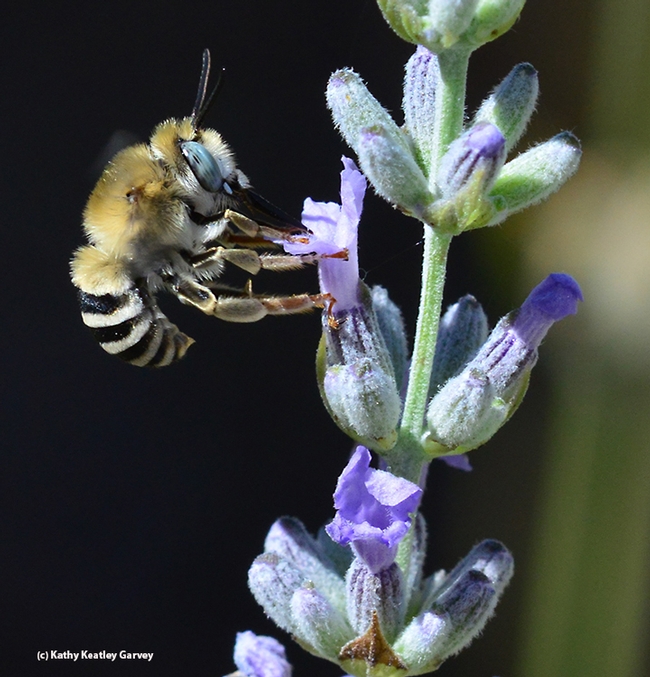- Author: Kathy Keatley Garvey
If you've ever been to Bodega Head in Sonoma County, you may have marveled at the waves crashing and the whales surfacing.
But have you ever seen the digger bees, Anthophora bomboides stanfordiana, aka bumble bee mimics, that nest in the sandstone cliffs?
They're there. They're foraging on flowers, excavating their nests, and rearing young.
These digger bees are not easy to photograph. On our May 9th trip, we got lucky: our 200mm macro lens picked up a digger bee warming its flight muscles.
"The species name indicates that it is a bumble bee mimic," the late Robbin Thorp (1933-2019), a global authority on bumble bees and a UC Davis distinguished emeritus professor of entomology. "These bees need a source of fresh water nearby. Females suck up water, regurgitate it on the sandstone bank surface, then dig away at the soft mud. They use some of the mud to build entrance turrets, presumably to help them locate their nests within the aggregation of nests."
"The female," Thorp said, "sucks up fresh water from nearby, stores it in her crop (like honey bees store nectar) for transport to the nest. She regurgitates it on the sandstone, and excavates the moistened soil. She carries out the mud and makes the entrance turret with it."
Thorp, a 30-year member of the Department of Entomology and Nematology, studied these bees. (See his presentation at the Proceedings of the Symposium on Biodiversity of Northwestern California, Santa Rosa, delivered in October 1991.)
Today, community ecologist and associate professor Rachel Vannette from the same department, is among scientists engaged in the research of these fascinating bees.
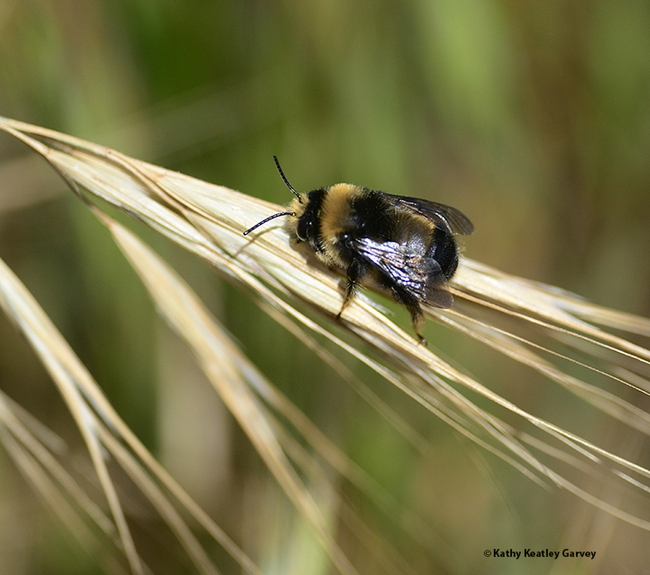
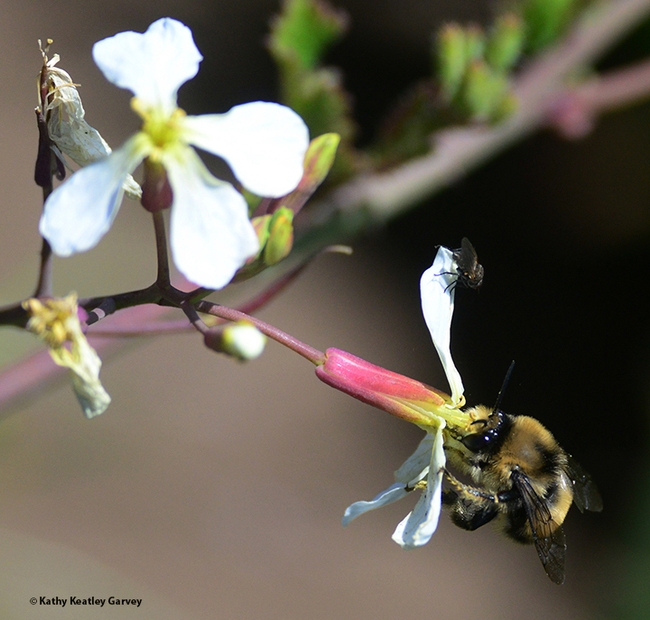
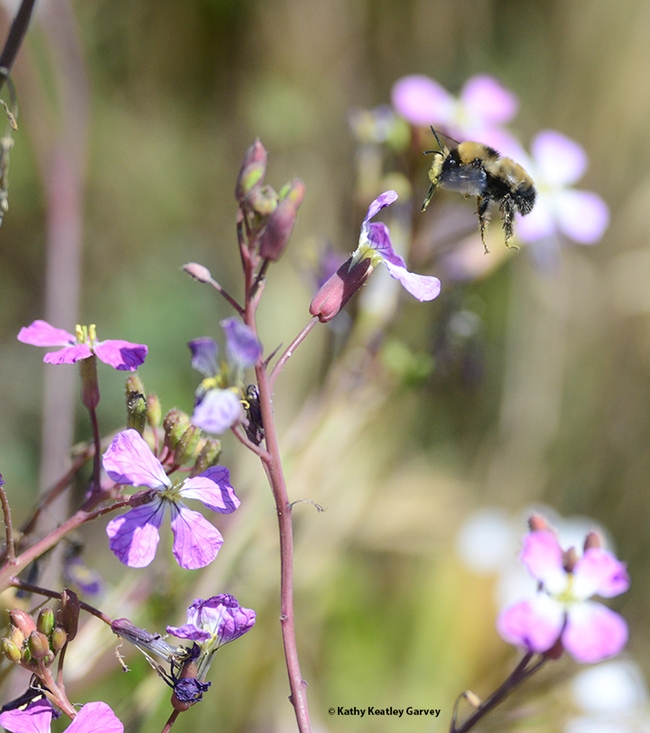
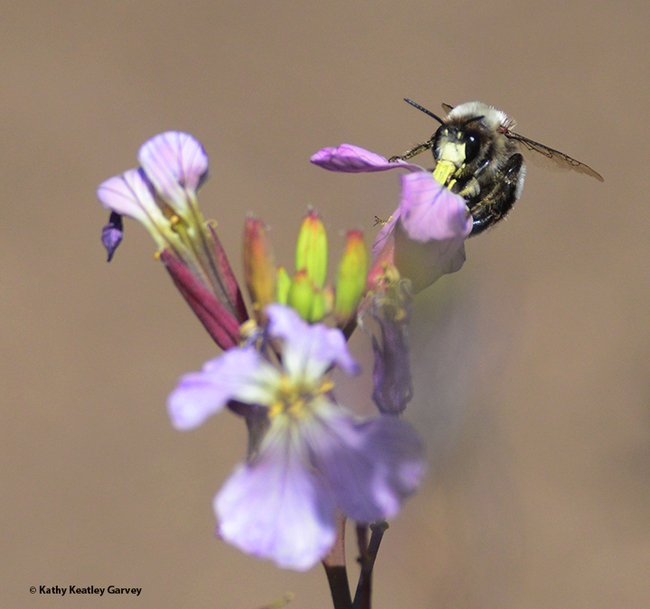
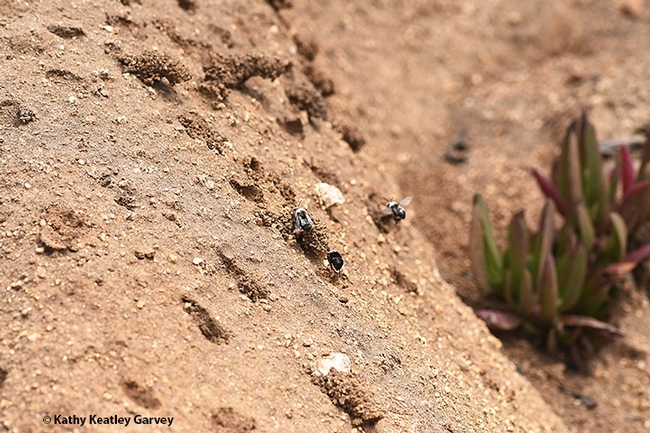
- Author: Kathy Keatley Garvey
Head to the Bodega Bay in Sonoma County and you'll see little kids building sandcastles on the beaches.
But head to Bodega Head in the spring and summer, and if you're lucky, you'll see female digger bees—bumble bee mimics—creating their own versions of sandcastles. These bees, Anthophora bomboides stanfordiana, build their nests in the sandy cliffs.
Look for the evidence: nest holes and tiny turrets.
If you missed it, be sure to access KQED's Deep Look video on “This Bee Builds Sandcastles at the Beach” by Gabriela Quirós and crew. It's educational, informative and entertaining. The photography is superb.
An excerpt from the Deep Look video: “It might seem peculiar to see bees at the beach. But the bumblebee-mimic digger bee (Anthophora bomboides stanfordiana) makes its home at beaches in Northern California and Oregon. Once they've mated, the females spend the spring digging their nests into sandy cliffs overlooking the Pacific Ocean.”
“They find a nearby source of water like a stream and slurp water into a pouch in their abdomen called a crop. They can make 80 daily trips back and forth from the stream to a cliff onto which they spray the water to soften it up. This allows them to dig a series of holes into which they lay their eggs.”
This digger bee is sometimes called the “Stanford bumble bee digger,” because the subspecies name, “stanfordiana,” refers to the Stanford University collection from 1904.
What do they mimic? The yellow-faced bumble bee, Bombus vosnesenskii, native to the West Coast of North America. But unlike the female bumble bees, female digger bees rarely sting and are not defensive.
The late Robbin Thorp (1933-2019), distinguished emeritus professor of entomology at UC Davis studied these bees. Current researchers include community ecologist Rachel Vannette, associate professor, UC Davis Department of Entomology and Nematology.
Thorp frequently pointed out that when most people think of bees, they think of honey bees. But there's a great diversity in bees, as he wrote in a paper, “Biodiversity and Pollination Biology of Bees in Coastal Nature Preserves,” that he and colleague Thomas Gordon presented at the Proceedings of the Symposium on Biodiversity of Northwestern California, held Oct. 28-30, 1991 in Santa Rosa. “The world bee fauna of bees (superfamily Apoidea) is estimated at 20,000 species,” they wrote. “Of these, about 10% are social, 75% are solitary, and 15 % are cuckoo parasites of other bees (Bohart, 1970).
“Bees are most diverse and abundant in arid warm temperate areas of the world, especially in the Mediterranean, California, and adjacent desert areas (Michener 1979),” they wrote. “With rare exceptions, bees rely on nectar and pollen as food resources: nectar primarily as energy for flight and other activities, pollen as nutrients for reproduction (ovarian and brood development). Most bees are generalists when foraging for nectar, restricted primarily by body or tongue size. Many bee species, however, exhibit host-specificity (oligolecty) in relation to pollen resources (Robertson, 1925; Linsley, 1958). Linsley and MacSwain (1958) define oligolecty as the collection of pollen from one or a few closely related plant species by all members of a bee species with use of alternative sources occurring only during stress periods when such pollen sources are locally (or temporarily) absent.”
“Bees are ‘keystone' species in most plant communities because of their importance as pollinators for the reproductive continuity of many flowering plants including rare and endangered species,” they related.
We've seen the digger bees at Bodega Bay foraging on wild radish and lupine in the spring and summer. And building sandcastles the ocean waves can't reach and people generally ignore.
Last week we saw a family checking out the holes in the sandy cliffs. “What are these?” they inquired.
“Digger bees, bumble-bee mimics,” I responded, mentioning the KQED “Deep Look” video.
They said they'd watch it.
We have a feeling they'll be back next year to watch the bees build their sandcastles.
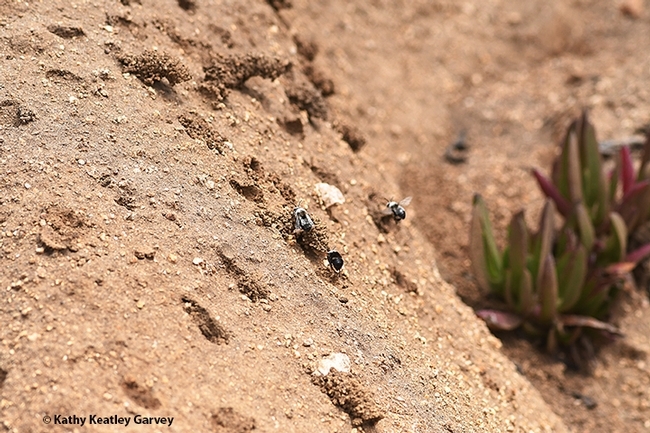
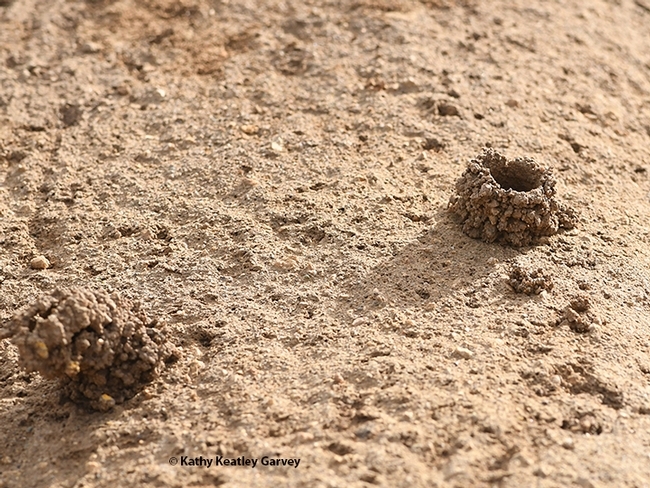
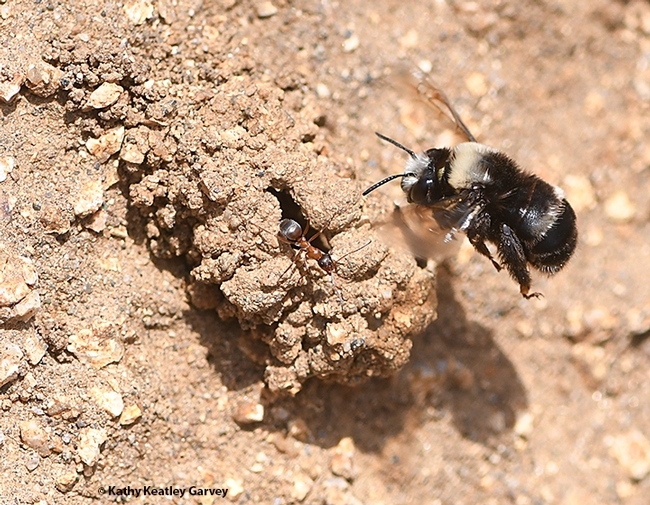
- Author: Kathy Keatley Garvey
There's more to Sonoma County's Bodega Head than the stunning views, crashing waves, nesting seabirds, and bursts of flora and fauna.
The sand cliffs are also the home of a digger bee, a bumble bee mimic known as Anthophora bomboides stanfordiana.
"The species name indicates that it is a bumble bee mimic," the late Robbin Thorp, a global authority on bumble bees and a UC Davis distinguished emeritus professor of entomology, told us several years ago. "These bees need a source of fresh water nearby. Females suck up water, regurgitate it on the sandstone bank surface, then dig away at the soft mud. They use some of the mud to build entrance turrets, presumably to help them locate their nests within the aggregation of nests."
"The female," Thorp said, "sucks up fresh water from nearby, stores it in her crop (like honey bees store nectar) for transport to the nest. She regurgitates it on the sandstone, and excavates the moistened soil. She carries out the mud and makes the entrance turret with it."
On multiple trips to Bodega Bay over the years, we watch in fascination as the bees excavate their homes, zip in and out of their turrets, and nectar on nearby flowers.
This time (June 24) we photographed an ant and bee encounter on a turret. The ant? Formica transmontanis, according to ant specialists Phil Ward, professor of entomology at UC Davis, and UC Davis alumnus Brendon Boudinot, who recently received his doctorate from UC Davis, studying with Ward.
"The species nests on the bluffs," Ward told us.
And about that bee-ant encounter? Commented Boudinot: "I suspect the little lady was alarmed by the big bee. These ants and their relatives are rather passive scavengers except during the brooding season, when fresh meat is an order. Most entomeat for Formica tend to be free-walking insects than barricaded larvae, as probably for the bee. For these reasons I think that the encounter may be coincidental!"
Scores of UC Davis entomologists have engaged in research at Bodega Bay. Rachel Vannette, assistant professor, UC Davis Department of Entomology and Nematology, is currently researching Anthophora bomboides stanfordiana and its nests as part of a National Science Foundation grant. Her project on solitary bee provision microbiome includes investigating the diverse community of bacteria and fungi in the provisions and brood cells.
While COVID-19 mandates and precautions hamper her research team's efforts (she's done some preliminary sampling this year and the entire team is planning to do research next year), the digger bees of Bodega Head keep digging, crafting turrets, nectaring on the nearby flora--and encountering ants.
They're all in this together.
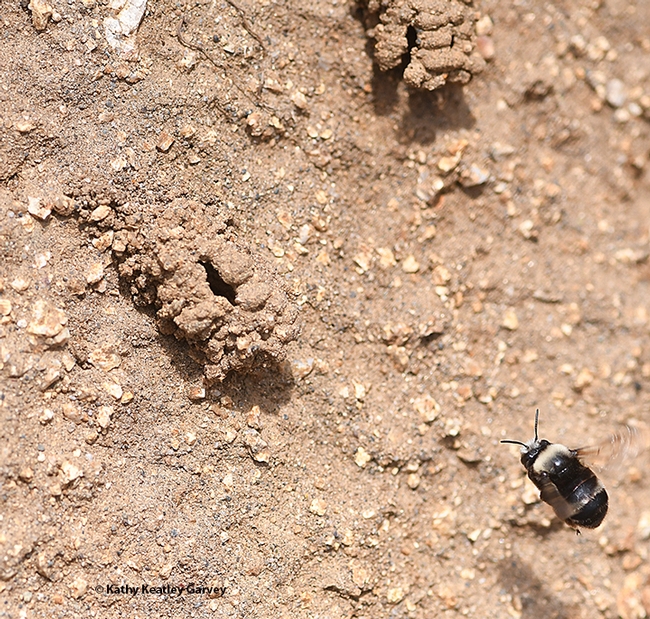
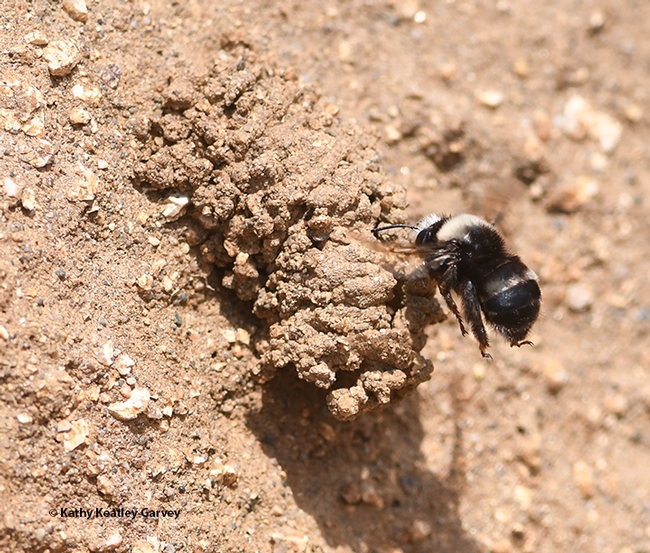
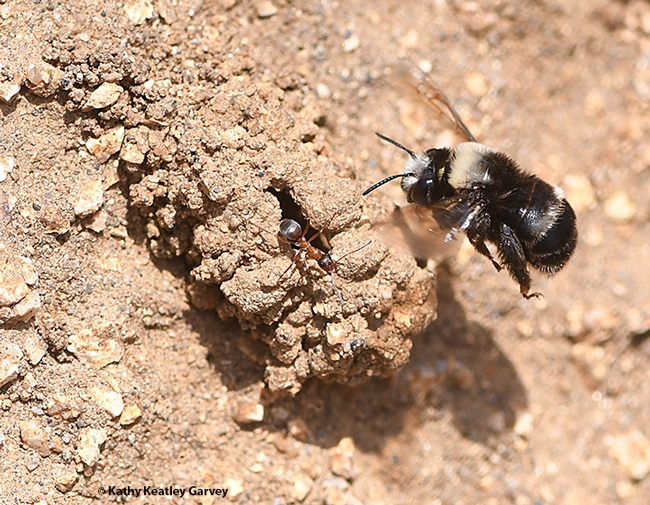
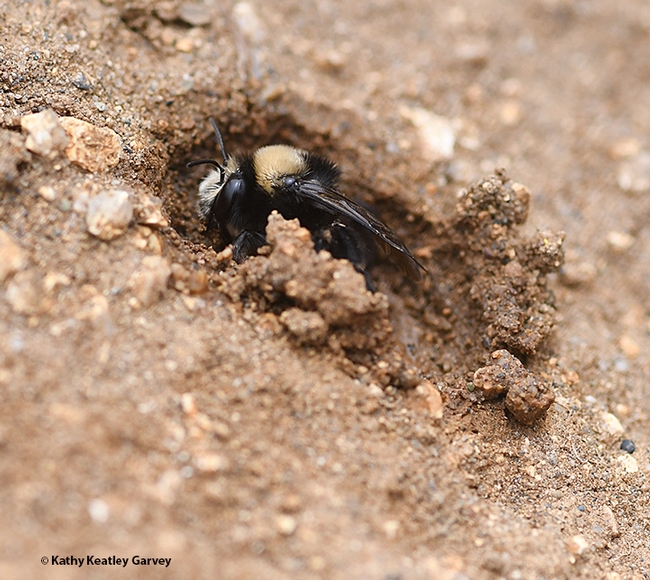
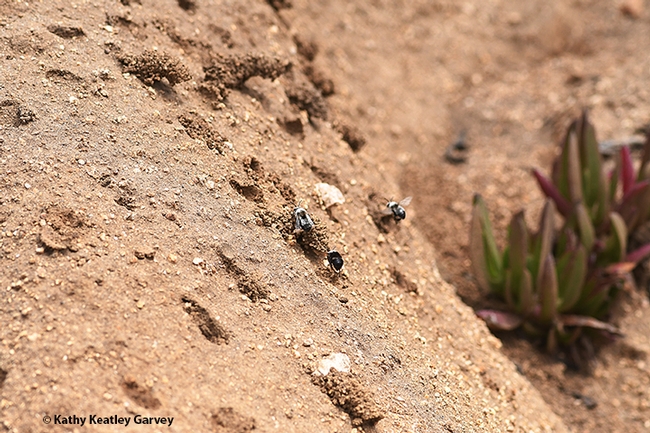
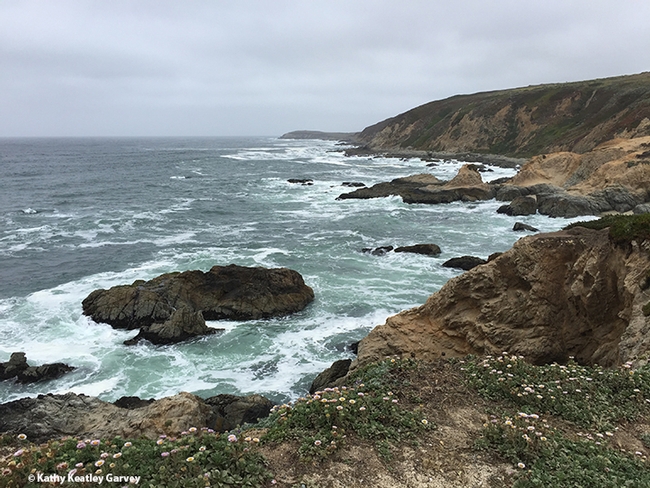
- Author: Kathy Keatley Garvey

Saul-Gershenz studies how blister beetle nest parasites mimic the sex pheromone of digger bees.
Bohart associate Emma Cluff curated the wall display, “Digger Bees and Their Nest Parasites,” which examines the life cycle, research process, results, research challenges and implications.
Saul-Gershenz, associate director of research, Wild Energy Initiative, at the John Muir Institute of the Environment, UC Davis, researches the chemical ecology and parasite-host interactions of these solitary native bees and their nest parasites across the western U. S., including the coastal sand dunes of Oregon and the Mojave Desert in south-central California.
Leslie did much of her work at the Mojave National Preserve, where she tracked the solitary bee Habropoda pallida and its nest parasite, a blister beetle, Meloe franciscanus.
The larvae of the parasitic blister beetle produce a chemical signal or allomone, similar to that of a female bee's pheromone, to lure males to the larval aggregation. The larvae attach to the male bee on contact and then transfer to the female during mating. The end result: the larvae wind up in the nest of a female bee, where they eat the nest provisions and likely the host egg.
Leslie's experiments found the allomones “released by each population of M. franciscanus triungulin (larvae) mimic the pheromones released by a specific species of Habropoda bees native to their local habitat,” Cluff wrote in the display. “Leslie found that these differences had a genetic basis. She also found that local bee species were more attracted to the allomones released by their local triungulin population.”
The M. franciscanus triungulin hatching is synchronized with the emergence of adult female Habropoda bees,” the display reads. “The triungulins aggregate on plant stems and release an allomone blend which attracts male bees. The aggregation of triungulins hop on to male bees who have chosen to investigate the allomone. Once the male bees find a real female bee, they mate in a ‘mating ball' at which time the triungulins transfer to the female. All this effort is so that the triungulins can get a free ride to the nest that the female bee lays her eggs in. Once inside the nest burrow, the triungulins will feed on the net provisions and likely the egg itself and will remain there until they emerge as adults the following winter.”
Results? “Leslie's experiments found that the allomones released by each population of M. franciscanus triungulin mimic the pheromones released by a the specific species of Habropoda” Cluff wrote. “Leslie found that these differences had a genetic basis. She also found that local bee species were more attracted to the allomones released by their local triungulin population.” The research contributes to the understanding of the communication signals of bees in the genus Habropoda.
Leslie, who holds a doctorate in entomology from UC Davis, is currently finishing two research papers: the basic biology of digger bee Habropoda pallida, and the biology of the silver digger bee Habropoda miserabilis.
She and her husband, Norman, are the co-founders of the Bay Area-based SaveNature.Org. The international conservation consortium works with partners to protect ecosystems around the world.
The Bohart Museum of Entomology, directed by Lynn Kimsey, professor of entomology at UC Davis, houses a global collection of nearly eight million insect specimens. It also includes a gift shop and a live "petting zoo," which includes Madagascar hissing cockroaches, walking sticks, and tarantulas. The museum is open to the public Monday through Thursday from 9 a.m. to noon and from 1 to 5 p.m., except during the holiday schedule. (See website)
The next open house, free and family friendly, will take place from 1 to 4 p.m., Saturday, Jan. 18. It will showcase "the amazing insect work that graduate students are doing," said Tabatha Yang, education and outreach coordinator. The theme is "Time Flies When You Are Studying Insects: Cutting Edge Student Research."
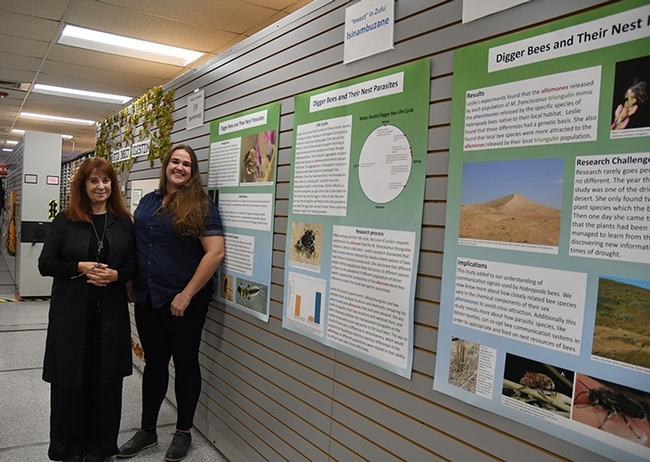
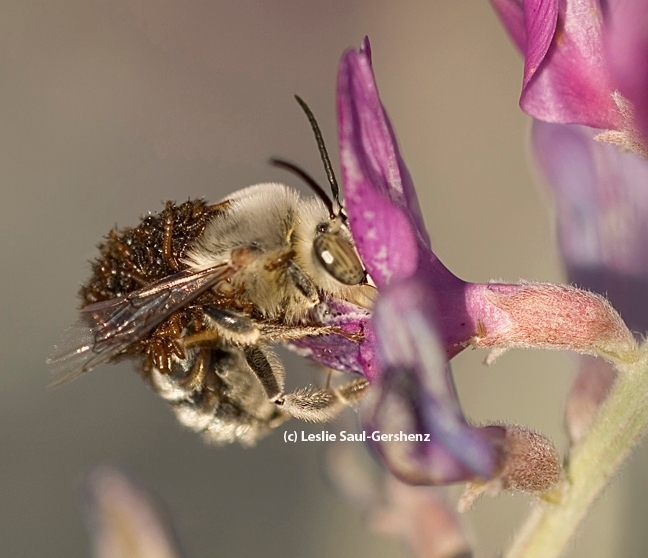
- Author: Kathy Keatley Garvey
Nice to see you!
In early spring and throughout most of the summer, we saw scores of digger bees, Anthophora urbana, living in our garden.
The very territorial males patrolled the flowers, trying to save them for the females (to mate with them). The boys kept dive bombing the other boys, along with assorted bees, butterflies, beetles and hover flies that had the "gall" to grab a little nectar from "their" blossoms.
We thought the Anthophora urbana season was over.
But on Tuesday, Sept. 22 we learned: "It's not!"
We saw a male Anthophora urbana buzz a monarch butterfly as it was fueling up on a Mexican sunflower (Tithonia). Sorry, that's mine!
Then it headed toward an English lavender. Yes, that's mine, too!
Native pollinate specialist Robbin Thorp, distinguished emeritus professor of entomology at UC Davis, and a co-author of California Bees and Blooms: A Guide for Gardeners and Naturalists, said "it seems rather late for a male of the species to be flying. Especially since he looks so fresh, hair and wing margin not showing signs of aging. But this has been a strange year for bee and flower phenologies."
California Bees and Blooms, the work of UC scientists, relates that many Anthophora are examples of California's early spring-to-summer "univoltine" bee species. They define "univoltine" as producing one generation per year. Compare that to bivoltine (two generations) and multivoltine (more).
The book is a dazzling wealth of information, and opens up the incredible world of insect treasures in your garden and what to plant to attract them. California is home to some 1600 species of bees, and Anthophora is just one of them.
